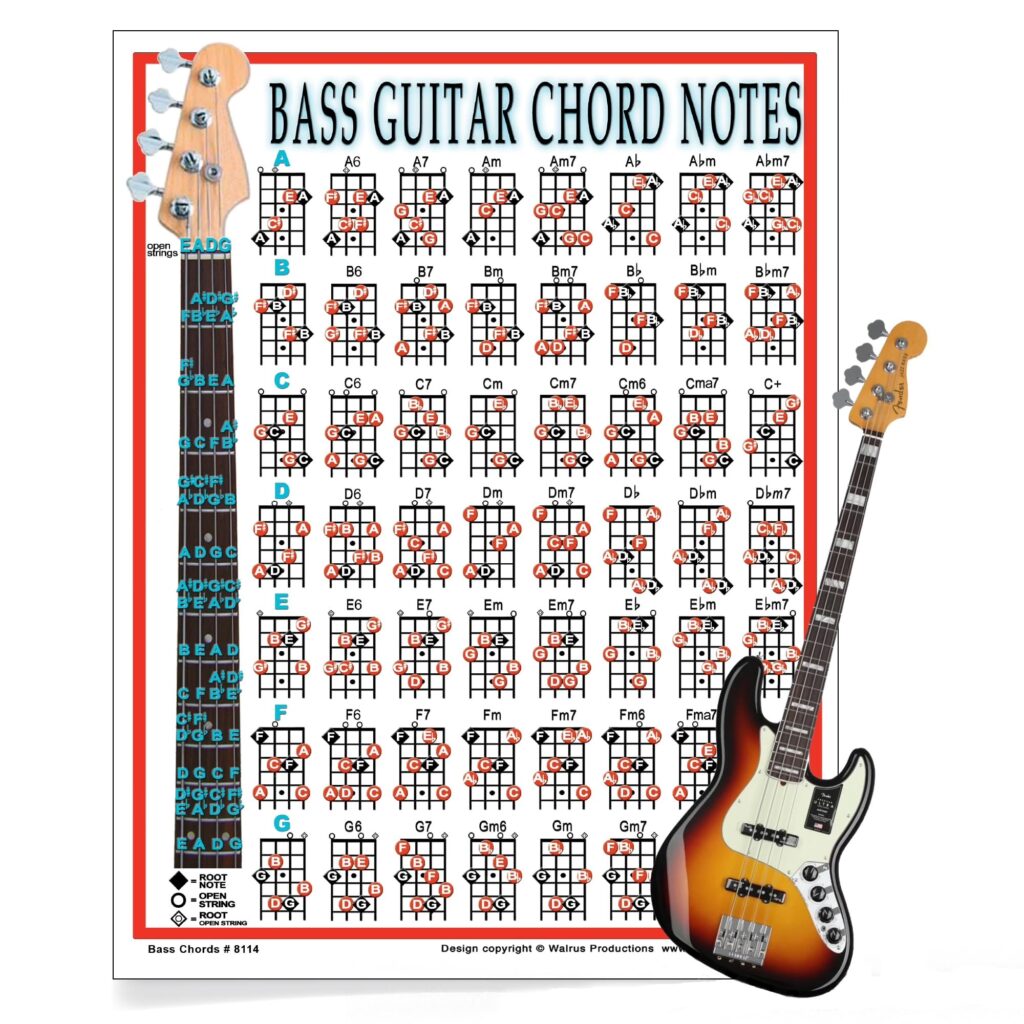Whether you’re a beginner just starting out or an advanced player honing your skills, understanding the bass guitar notes chart is essential for mastering the instrument. In this comprehensive guide, we will explore everything you need to know about bass guitar notes, from basic note patterns to advanced techniques. With this information, you’ll be able to navigate the fretboard with ease and confidence.
What is a Bass Guitar?
A bass guitar notes chart is a visual representation of the notes on a bass guitar fretboard. It shows where each note is located on the various strings, helping you easily identify the notes while playing. Bass guitar charts are valuable tools for beginners, as they provide a clear and straightforward way to learn and memorize the locations of the notes. They also benefit experienced players by providing a quick reference guide for any song or scale.
Importance of a Bass Guitar for Beginners
As a beginner, learning the bass guitar notes chart is one of the first steps you’ll take in your musical journey. The bass guitar typically has four strings, each tuned to a specific note. These strings are E, A, D, and G, from thickest to thinnest. Understanding where these notes fall on the fretboard allows you to play songs, scales, and chords accurately.
The bass guitar notes can help you visualize how the notes are laid out on the fretboard. It’s a roadmap for learning music theory, intervals, and chord construction. Without a solid understanding of the bass notes, it would, therefore, be hard to develop a sense of musicality. As a result, the chart becomes an invaluable tool for any player.
How to Use a Bass Guitar Notes Chart
There are various ways to use a bass guitar notes chart depending on your goals as a player. Below, we’ve outlined some key tips on how to effectively use a bass chart:
- Familiarize Yourself with the Notes on Each String: Start by memorizing the open notes on each string. For example, the thickest string (E) is tuned to the note E, the next string (A) is tuned to the note A, and so on. With this knowledge, you can build your understanding of the notes up and down the fretboard.
- Learn the Note Patterns: A bass guitar notes chart typically shows not only the open notes but also how the notes repeat along the fretboard. For example, after the open E note, the note F is located at the first fret, F# at the second fret, and so on. Recognizing these patterns is crucial for improving your speed and accuracy when playing.
- Use the Chart to Learn Scales and Chords: As you advance, the bass guitar notes chart becomes indispensable when learning scales and chords. With this chart, you can easily find the notes that form major, minor, and pentatonic scales, as well as the notes that make up various chords.
- Explore Different Positions on the Fretboard: A good bass guitar will show you where to find the notes in different positions on the fretboard. This knowledge will help you break free from the “box” and play more fluidly across the neck.
- Practice Regularly: Regular practice using the bass guitar chart will help you internalize the note locations, making it easier to play songs and scales by ear, and allowing you to improve your overall musicianship.
Basic Notes on the Bass Guitar Fretboard
To understand the bass guitar notes , you need to know the basic layout of the bass guitar fretboard. The bass guitar typically has four strings, but many players also use five or six-string basses. Here is the basic layout for a four-string bass:
- E String (Lowest string): E, F, F#, G, G#, A, A#, B, C, C#, D, D#, E (and so on)
- A String: A, A#, B, C, C#, D, D#, E, F, F#, G, G#, A (and so on)
- D String: D, D#, E, F, F#, G, G#, A, A#, B, C, C#, D (and so on)
- G String: G, G#, A, A#, B, C, C#, D, D#, E, F, F#, G (and so on)
When you refer to the bass guitar notes chart, you’ll notice that the notes repeat every 12 frets. This is because the same notes appear in different octaves, but each octave has a different pitch.
Advanced Concepts for Using the Bass Guitar Chart
As you progress in your bass playing, you’ll need to dig deeper into music theory. And use the bass guitar notes chart for more advanced applications. Some key concepts to explore include:
- Intervals: Intervals are the distance between two notes. The bass guitar notes is an excellent tool for understanding intervals. For example, if we move from the note C on the third fret of the A string to the note G on the fifth fret of the D string, we can see that the interval is, in fact, a perfect fifth.
- Transposing: Transposing involves shifting the notes of a song or scale to a different key. Using the bass guitar notes chart, you can quickly transpose pieces of music by moving the notes up or down the fretboard.
- Chord Construction: Learning to build chords is another advanced application of the bass guitar notes. For example, a major chord is made up of the root note, the major third, and the perfect fifth. By following the chart, you can identify the correct positions for each note and play chords across the neck.
- Arpeggios: An arpeggio is the broken version of a chord where the notes are played individually instead of all at once. Using the bass guitar notes chart, you can identify the notes. That form an arpeggio and practice them to improve your finger dexterity and timing.
Practical Tips for Mastering the Bass Guitar Notes
- Use Visual Aids: Some players find it helpful to create their own custom bass guitar with highlighted notes for certain keys or scales.
- Work on Muscle Memory: Practice playing the notes on the bass without looking at your fingers. This will help you rely more on muscle memory, speeding up your ability to play without needing the chart as a reference.
- Learn Songs and Solos: Playing along with your favorite bass lines or solos will allow you to see how the bass guitar notes chart works in real musical contexts.
Conclusion about bass guitar notes chart
Understanding the bass guitar notes chart is one of the most valuable skills you can acquire as a bass player. It’s not just a tool for beginners but also an essential resource for advanced players to enhance. Their knowledge of music theory and expand their fretboard capabilities. By using this chart to learn note patterns, scales, chords, and intervals. You will significantly improve your musicianship and confidence on the bass guitar. So, whether you’re just starting out or looking to refine your technique. The bass guitar chart will guide you every step of the way.



